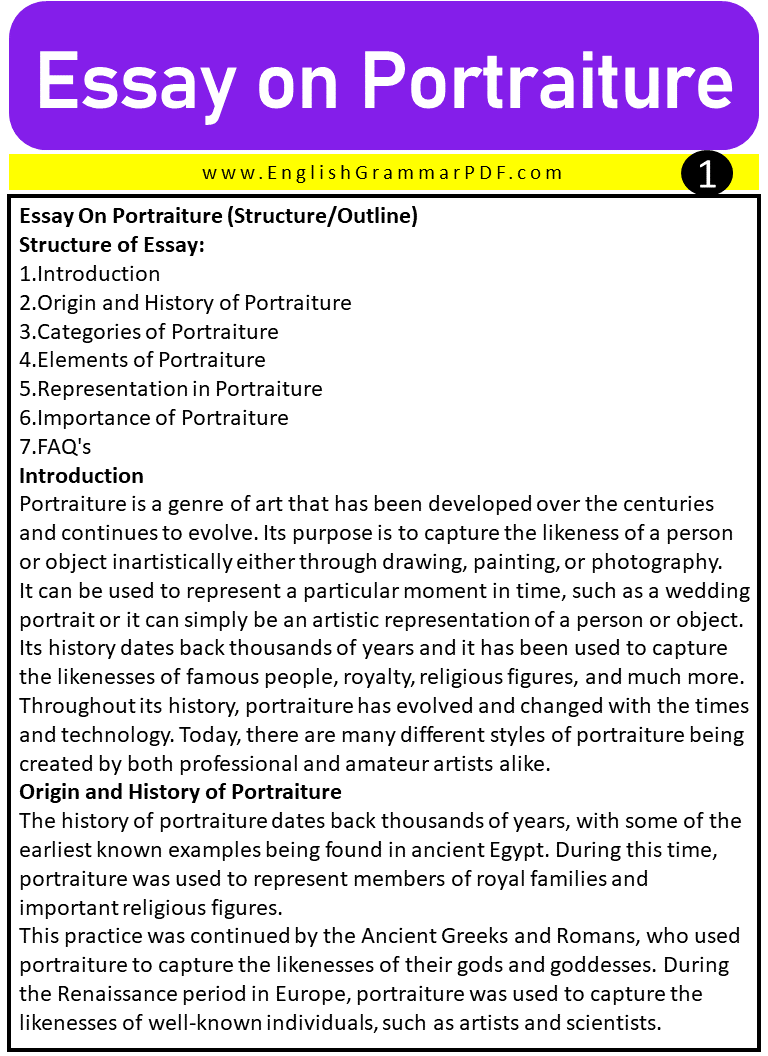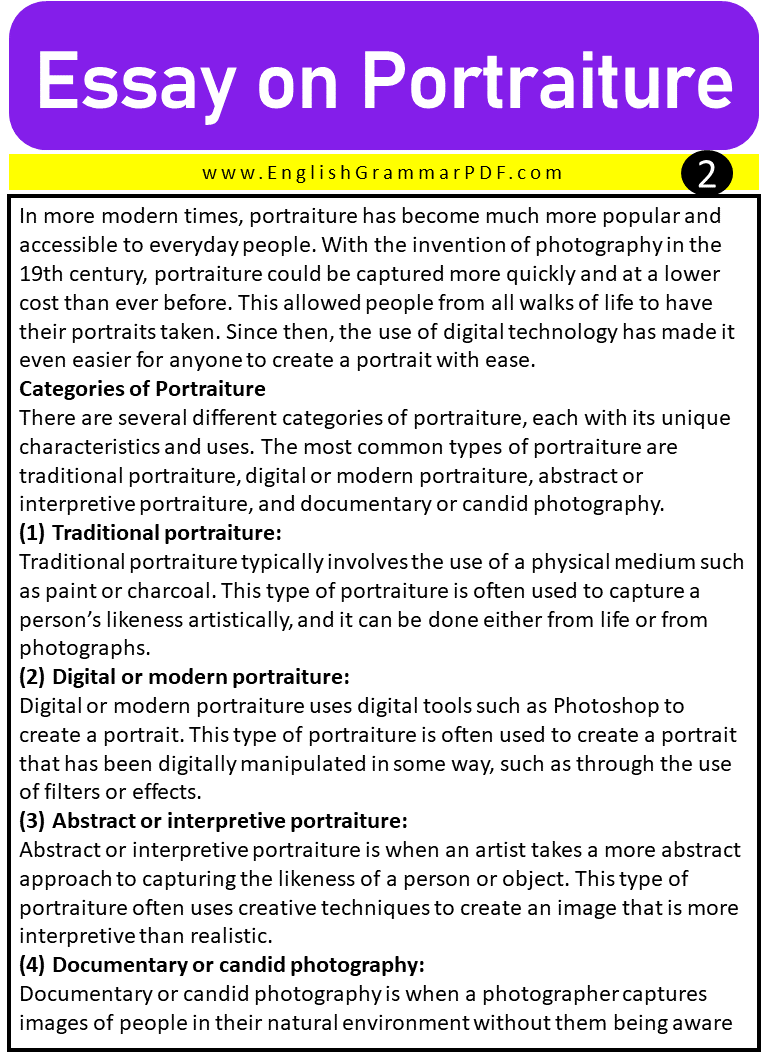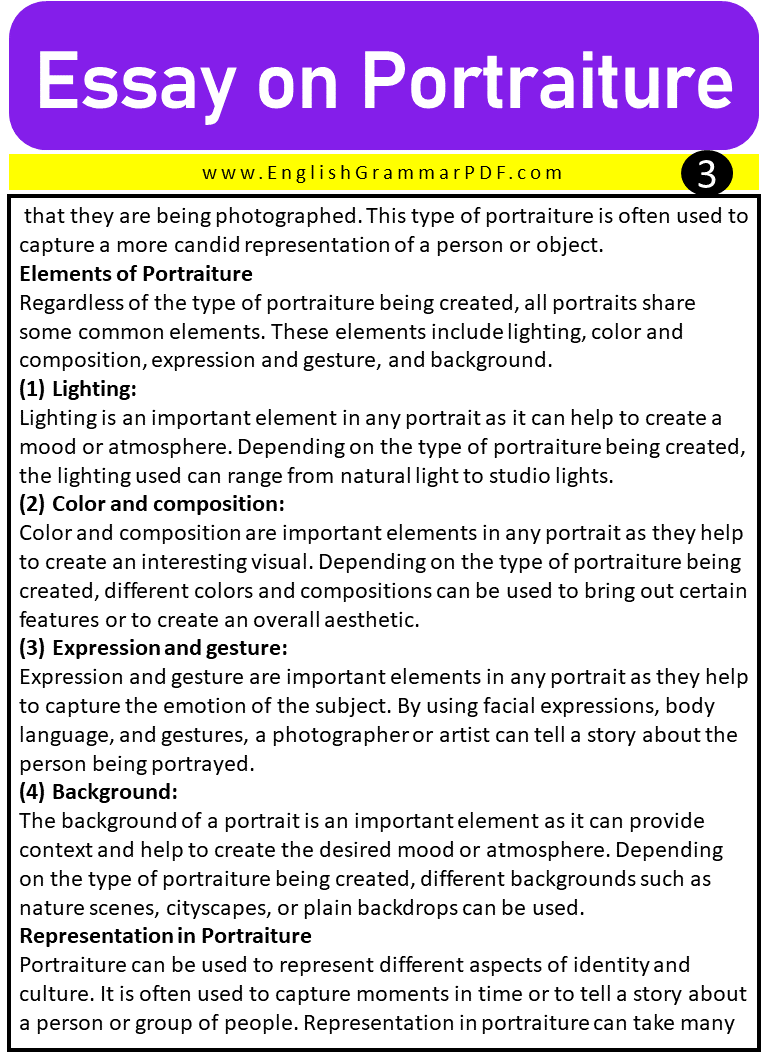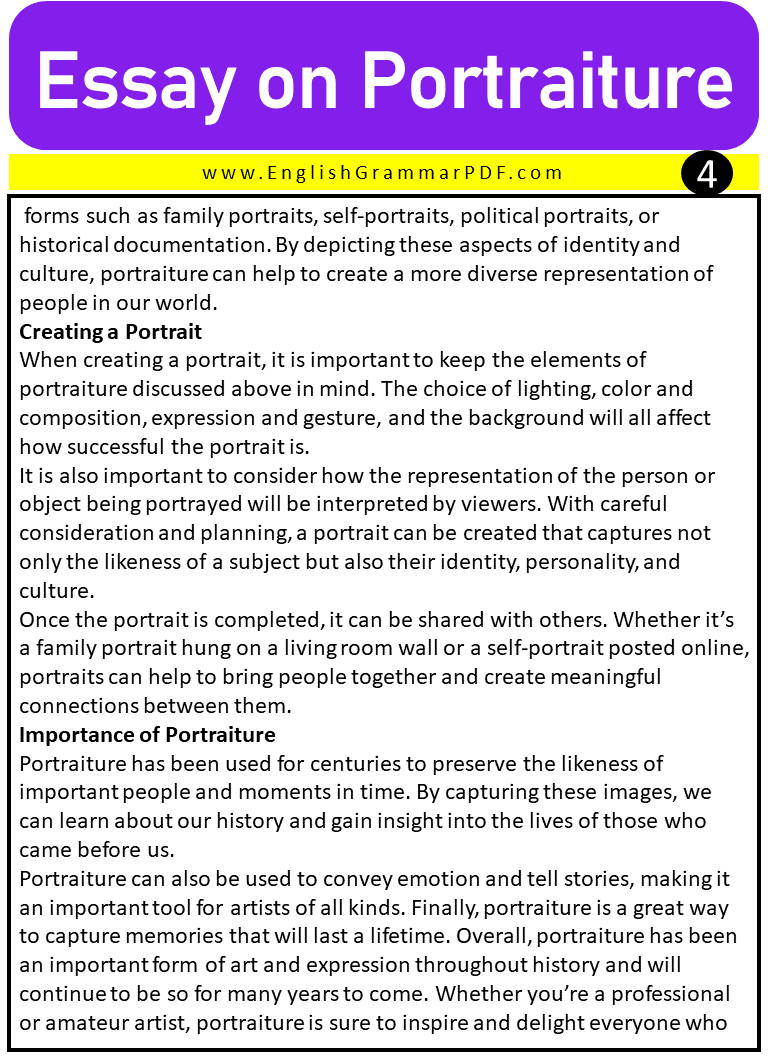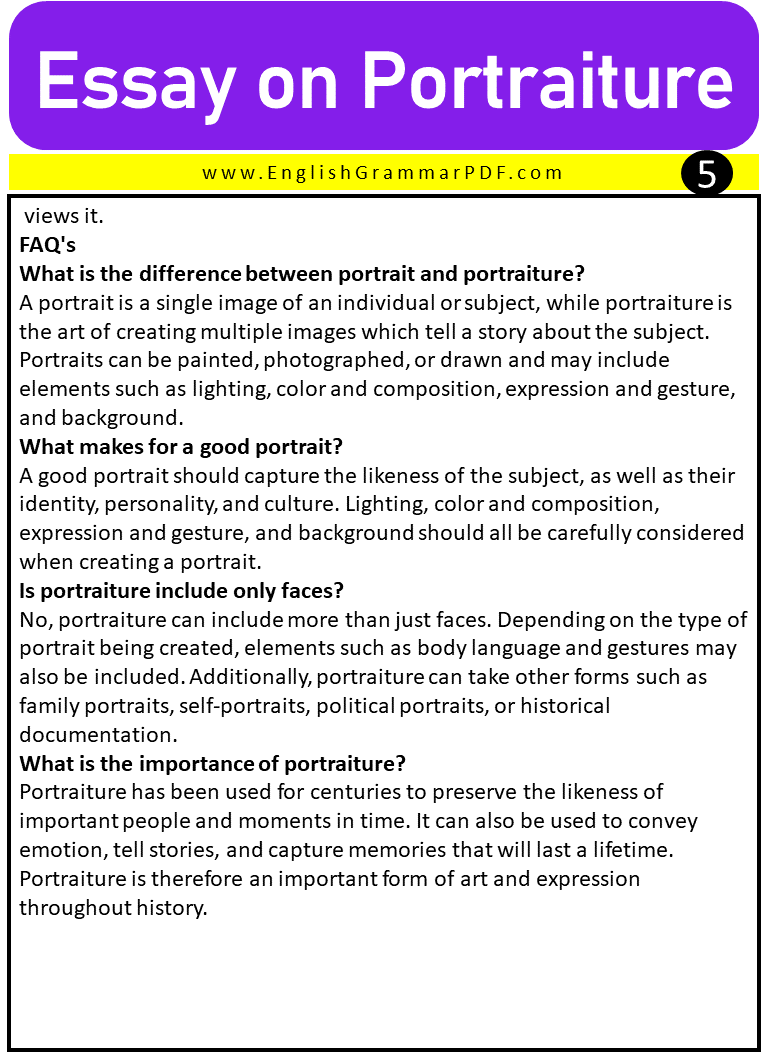Essay On Portraiture (Structure/Outline)
- Introduction
- Origin and History of Portraiture
- Categories of Portraiture
- Elements of Portraiture
- Representation in Portraiture
- Importance of Portraiture
- FAQ’s
Introduction
Portraiture is a genre of art that has been developed over the centuries and continues to evolve. Its purpose is to capture the likeness of a person or object inartistically either through drawing, painting, or photography.
It can be used to represent a particular moment in time, such as a wedding portrait or it can simply be an artistic representation of a person or object. Its history dates back thousands of years and it has been used to capture the likenesses of famous people, royalty, religious figures, and much more.
Throughout its history, portraiture has evolved and changed with the times and technology. Today, there are many different styles of portraiture being created by both professional and amateur artists alike.
Discover More:
Essay On Patient-Centered Care
Origin and History of Portraiture
The history of portraiture dates back thousands of years, with some of the earliest known examples being found in ancient Egypt. During this time, portraiture was used to represent members of royal families and important religious figures.
This practice was continued by the Ancient Greeks and Romans, who used portraiture to capture the likenesses of their gods and goddesses. During the Renaissance period in Europe, portraiture was used to capture the likenesses of well-known individuals, such as artists and scientists.
In more modern times, portraiture has become much more popular and accessible to everyday people. With the invention of photography in the 19th century, portraiture could be captured more quickly and at a lower cost than ever before. This allowed people from all walks of life to have their portraits taken. Since then, the use of digital technology has made it even easier for anyone to create a portrait with ease.
Categories of Portraiture
There are several different categories of portraiture, each with its unique characteristics and uses. The most common types of portraiture are traditional portraiture, digital or modern portraiture, abstract or interpretive portraiture, and documentary or candid photography.
(1) Traditional portraiture:
Traditional portraiture typically involves the use of a physical medium such as paint or charcoal. This type of portraiture is often used to capture a person’s likeness artistically, and it can be done either from life or from photographs.
(2) Digital or modern portraiture:
Digital or modern portraiture uses digital tools such as Photoshop to create a portrait. This type of portraiture is often used to create a portrait that has been digitally manipulated in some way, such as through the use of filters or effects.
(3) Abstract or interpretive portraiture:
Abstract or interpretive portraiture is when an artist takes a more abstract approach to capturing the likeness of a person or object. This type of portraiture often uses creative techniques to create an image that is more interpretive than realistic.
(4) Documentary or candid photography:
Documentary or candid photography is when a photographer captures images of people in their natural environment without them being aware that they are being photographed. This type of portraiture is often used to capture a more candid representation of a person or object.
Elements of Portraiture
Regardless of the type of portraiture being created, all portraits share some common elements. These elements include lighting, color and composition, expression and gesture, and background.
(1) Lighting:
Lighting is an important element in any portrait as it can help to create a mood or atmosphere. Depending on the type of portraiture being created, the lighting used can range from natural light to studio lights.
(2) Color and composition:
Color and composition are important elements in any portrait as they help to create an interesting visual. Depending on the type of portraiture being created, different colors and compositions can be used to bring out certain features or to create an overall aesthetic.
(3) Expression and gesture:
Expression and gesture are important elements in any portrait as they help to capture the emotion of the subject. By using facial expressions, body language, and gestures, a photographer or artist can tell a story about the person being portrayed.
(4) Background:
The background of a portrait is an important element as it can provide context and help to create the desired mood or atmosphere. Depending on the type of portraiture being created, different backgrounds such as nature scenes, cityscapes, or plain backdrops can be used.
Representation in Portraiture
Portraiture can be used to represent different aspects of identity and culture. It is often used to capture moments in time or to tell a story about a person or group of people. Representation in portraiture can take many forms such as family portraits, self-portraits, political portraits, or historical documentation. By depicting these aspects of identity and culture, portraiture can help to create a more diverse representation of people in our world.
Creating a Portrait
When creating a portrait, it is important to keep the elements of portraiture discussed above in mind. The choice of lighting, color and composition, expression and gesture, and background will all affect how successful the portrait is.
It is also important to consider how the representation of the person or object being portrayed will be interpreted by viewers. With careful consideration and planning, a portrait can be created that captures not only the likeness of a subject but also their identity, personality, and culture.
Once the portrait is completed, it can be shared with others. Whether it’s a family portrait hung on a living room wall or a self-portrait posted online, portraits can help to bring people together and create meaningful connections between them.
Importance of Portraiture
Portraiture has been used for centuries to preserve the likeness of important people and moments in time. By capturing these images, we can learn about our history and gain insight into the lives of those who came before us.
Portraiture can also be used to convey emotion and tell stories, making it an important tool for artists of all kinds. Finally, portraiture is a great way to capture memories that will last a lifetime. Overall, portraiture has been an important form of art and expression throughout history and will continue to be so for many years to come. Whether you’re a professional or amateur artist, portraiture is sure to inspire and delight everyone who views it.
FAQ’s
What is the difference between portrait and portraiture?
A portrait is a single image of an individual or subject, while portraiture is the art of creating multiple images which tell a story about the subject. Portraits can be painted, photographed, or drawn and may include elements such as lighting, color and composition, expression and gesture, and background.
What makes for a good portrait?
A good portrait should capture the likeness of the subject, as well as their identity, personality, and culture. Lighting, color and composition, expression and gesture, and background should all be carefully considered when creating a portrait.
Is portraiture include only faces?
No, portraiture can include more than just faces. Depending on the type of portrait being created, elements such as body language and gestures may also be included. Additionally, portraiture can take other forms such as family portraits, self-portraits, political portraits, or historical documentation.
What is the importance of portraiture?
Portraiture has been used for centuries to preserve the likeness of important people and moments in time. It can also be used to convey emotion, tell stories, and capture memories that will last a lifetime. Portraiture is therefore an important form of art and expression throughout history.
Essay On Portraiture Pdf
